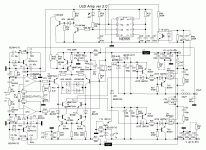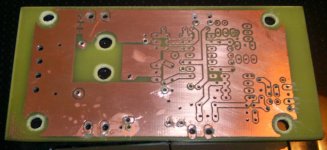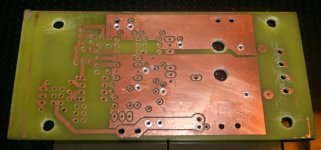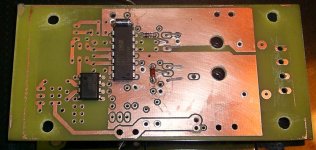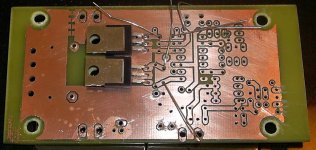hi opor what kind of capacitor did u use? ceramic or poliester?
I used ceramic cap but I have try polypropylene ,nothing is improved.
looks like people are having problems with inductor and noise..
I'm having the same problems.. I thinks its a common problem for UCD amplifiers.. because I have built many class AB amps including chip amps which dont have this noise problems.
I would say that if you give some attention to output inductor then it will reduce the extra noise coming out from switching. it has to be 30uH or very close value with output cap 1.5uF
40uH or 50uH would go together with 1uF
varying values will affect the output filter bandwidth which might release noises.
In my experience, this amp will generate more noise when plug it to PC. because it amplifies the noise. will be good with a noise free player.
if you have problems with winding turns and selecting cores this link might help you.
toroids
it says.....
The permeabilities or in this case AL factors i.e. ( inductance per 100 turns2 ) are:
TYPE COLOR AL Freq. Range
T50-26 Yel-Wh 320uH power freq.
T50-3 Gray 175 50 Khz to 500 Khz
T50-1 Blue 100 500 Khz to 5 Mhz
T50-2 Red 57 2 Mhz to 30 Mhz
T50-6 Yellow 47 10 to 50 Mhz
T50-10 Black 32 30 to 100 Mhz
This is only a small sample to give you an idea. Your turns required to give a certain inductance based on the above AL is as follows:
N = 100 * root of([ L / AL])
Therefore to obtain an inductance of 3.685 uH using a T50-6 toroid would require 28 turns (of course I cheated again) but check it out on your calculator as I may have left in a deliberate mistake to see if you're awake.
I prefer
T50-3 Gray 175 50 Khz to 500 Khz
and calculations says around 42 turns..
build your own with a proper calculation.
regards,
Lycanlk
I'm having the same problems.. I thinks its a common problem for UCD amplifiers.. because I have built many class AB amps including chip amps which dont have this noise problems.
I would say that if you give some attention to output inductor then it will reduce the extra noise coming out from switching. it has to be 30uH or very close value with output cap 1.5uF
40uH or 50uH would go together with 1uF
varying values will affect the output filter bandwidth which might release noises.
In my experience, this amp will generate more noise when plug it to PC. because it amplifies the noise. will be good with a noise free player.
if you have problems with winding turns and selecting cores this link might help you.
toroids
it says.....
The permeabilities or in this case AL factors i.e. ( inductance per 100 turns2 ) are:
TYPE COLOR AL Freq. Range
T50-26 Yel-Wh 320uH power freq.
T50-3 Gray 175 50 Khz to 500 Khz
T50-1 Blue 100 500 Khz to 5 Mhz
T50-2 Red 57 2 Mhz to 30 Mhz
T50-6 Yellow 47 10 to 50 Mhz
T50-10 Black 32 30 to 100 Mhz
This is only a small sample to give you an idea. Your turns required to give a certain inductance based on the above AL is as follows:
N = 100 * root of([ L / AL])
Therefore to obtain an inductance of 3.685 uH using a T50-6 toroid would require 28 turns (of course I cheated again) but check it out on your calculator as I may have left in a deliberate mistake to see if you're awake.
I prefer
T50-3 Gray 175 50 Khz to 500 Khz
and calculations says around 42 turns..
build your own with a proper calculation.
regards,
Lycanlk
continued noise
hi guys yes there is small noise even after adding 4.7 nf to lm311 pin 3 and grounding .but the simplicity of the amp and the power it produces that is a trade of i am o.k with . but if it is a bother then guys let us think of adding a different feed back design. e.g. the scheme below is a discreet ucd except the input op amp . i tried the amp with non smd that is 2n5401 and 2n5551 and made it on a strip board. when i grounded the negative side of input, the amp was dead silent. i tend to think the feed back design is better than the one we are using. stewin
hi guys yes there is small noise even after adding 4.7 nf to lm311 pin 3 and grounding .but the simplicity of the amp and the power it produces that is a trade of i am o.k with . but if it is a bother then guys let us think of adding a different feed back design. e.g. the scheme below is a discreet ucd except the input op amp . i tried the amp with non smd that is 2n5401 and 2n5551 and made it on a strip board. when i grounded the negative side of input, the amp was dead silent. i tend to think the feed back design is better than the one we are using. stewin
Attachments
AL factors i.e. ( inductance per 100 turns2 )
Al is inductance in nH / turn^2
Btw: exact inductance is absolutely unimportant in a well-designed UcD amp.
Last edited:
I'm having the same problems.. I thinks its a common problem for UCD amplifiers.. because I have built many class AB amps including chip amps which dont have this noise problems.
...
regards,
Lycanlk
I've built some UcD based amplifiers, and many other ClassD amp, and a few of them produced noise (interference) when I connected to PC, but I was always able to eliminate it. The main reason was not proper grounding system.
hi andrew, the power remains the same
i use +/- 29Volts so i get 50W RMS on 8 ohm speakers (speakers i have)
the IRF640's are much faster than irfp260 or 250
for heatsink i use...i use...simple air no heatsink
no heatsink 
at full power the IRF's stay cool the TIP is 35 degrees
for filter inductor:T130-2 micrometals 50 turns with Litzwire 1,5mm dia
capacitor:1uF/63V WIMA MKP-4 (for audio use)
added 4,7nF polyester from pin 3 off LM to GND
now i plan to add a OPAMP TL071 or OPA132 buffer in front off the amp to see if i get noise when i connect to PC souncard or other signal source other than the mp3 player
greetings
i use +/- 29Volts so i get 50W RMS on 8 ohm speakers (speakers i have)
the IRF640's are much faster than irfp260 or 250
for heatsink i use...i use...simple air
at full power the IRF's stay cool the TIP is 35 degrees
for filter inductor:T130-2 micrometals 50 turns with Litzwire 1,5mm dia
capacitor:1uF/63V WIMA MKP-4 (for audio use)
added 4,7nF polyester from pin 3 off LM to GND
now i plan to add a OPAMP TL071 or OPA132 buffer in front off the amp to see if i get noise when i connect to PC souncard or other signal source other than the mp3 player
greetings
Last edited:
I've built some UcD based amplifiers, and many other ClassD amp, and a few of them produced noise (interference) when I connected to PC, but I was always able to eliminate it. The main reason was not proper grounding system.
what do you mean by this ?? proper grounding system?? can you further express taking a scenario that you have faced with?? what class D or UCD amps have you built so far which is working without noise??
and give us a clear and right thing to eliminate noise of this UCD amp.. finally thats what we all need.. I'll appreciate your comments ! thanking you in advance !
regards,
Lycanlk
what do you mean by this ?? proper grounding system?? can you further express taking a scenario that you have faced with??
Sorry, the last time I experienced this issue was a couple of years ago, I don't remember the details. By groundig system I mean both internal ground plane and external one, common mode filters, EMI shields, etc... Anything can be wrong, but if you don't have a clean GND, then it's almost impossible to measure, and not easy to filter the disturbance.
I have a friend who made a noise-free ClassD amp on single-layer PCB, but it took many experiments. I use double layer PCB with ground layer and SMD, and I have no such problems, but these things alone are not enough for good result.
what class D or UCD amps have you built so far which is working without noise??
UcD with many kind of level shifter+gate driver, pre-filter phase-shift oscillating type, fixed freq PWM with post- or pre-filter feedback, BCA topology, Class BD modulation, almost everything wich is analog. Noise is not unavoidable in any method/topology. It's because of realisation.
and give us a clear and right thing to eliminate noise of this UCD amp.. finally thats what we all need..
I can't, and I don't want to do this. This is your task. All I want to say is: this is possible, and the cause of the problem is not UcD topology.
I could eliminate the noise personally, but not through the internet. It requires seeing the complete arrangement, hearing the noise, maybe measuring some waveform with a good oscilloscope, and some experiments.
You can try changing switch freq, but this is only symptomatic treatment!
To determine the disturbing signal's penetration point the most important test is shorting the input. Depending on the result you can continue inspection in different ways.
Last edited:
I didn't tell the trueth: I solved a similar problem a month ago, but it was different, more difficult: 2 amplifiers + center tapped push-pull PWM power supply, heat-sinks attached to metal case, plus ground loop. There were 4 different kinds of noise, and all of them needed a different solution. And 3 of the noises introduced with the improper housing.
I didn't tell the trueth: I solved a similar problem a month ago, but it was different, more difficult: 2 amplifiers + center tapped push-pull PWM power supply, heat-sinks attached to metal case, plus ground loop. There were 4 different kinds of noise, and all of them needed a different solution. And 3 of the noises introduced with the improper housing.
Its not the fact that you didnt tell the truth.. building a UCD amp is not ease as class AB when it comes to eliminate the noise. Of cause there's nothing to do with the topology because people have proven its a working amp and the simplest UCD that I have ever seen so far.
The questions I have raised to realize that area I should recheck or consider to eliminate the noise. to get a clear sound to my ear
building a UCD amp is not ease as class AB when it comes to eliminate the noise
Ooops, I forgot to mention: those amplifiers were Class D also of course (however fixed freq). Class AB is out of question here.
I've never experienced noise with only one UCD, unless it was supplied by hard switching SMPS.
Thanks for your contribution.
You're welcome!
So heres my board after etching:
With a few components in place:
Now im waiting for some components i had to order before i can warm up the soldering station.
With a few components in place:
Now im waiting for some components i had to order before i can warm up the soldering station.
Attachments
Last edited by a moderator:
- Home
- Amplifiers
- Class D
- UCD 25 watts to 1200 watts using 2 mosfets
